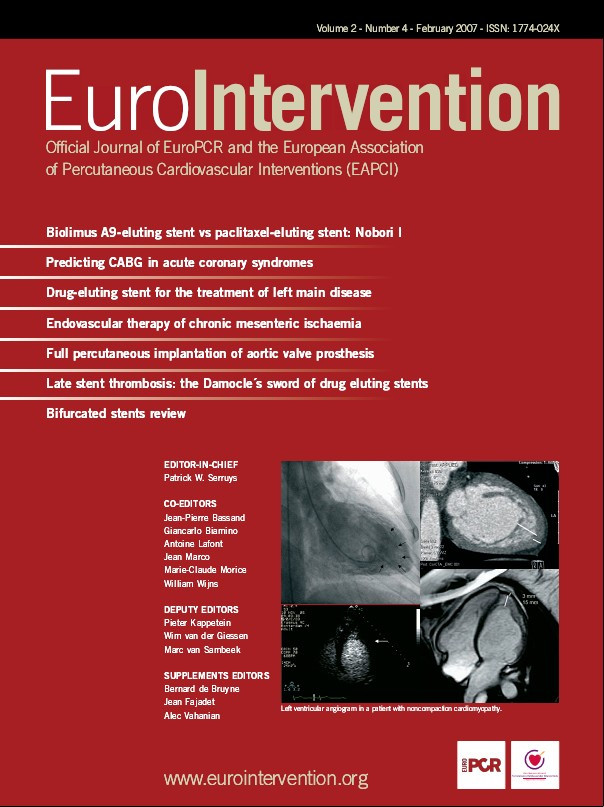It is uncertain where the soul lives. One cardiovascular school of thought is that it lives in the left main coronary artery - accordingly, if there are problems with the left main coronary artery, the soul flies away. This notion was perhaps first exemplified by Herrick’s1 description of a 55-year-old man who was “seized an hour after a moderately full meal with severe pain in the lower precordial region”. This patient subsequently developed cardiogenic shock and then died, and at the time of autopsy, the left coronary artery was found to be completely obliterated by a red thrombus a short distance from its origin that had formed at the point of ‘great narrowing’. The importance of left main coronary artery disease was further underscored by the early Veterans Administration study2 which documented that surgical revascularisation in patients with left main coronary artery disease was associated with a survival advantage compared with what was then standard medical therapy. The mantra that surgical revascularisation should be undertaken whenever possible held sway until the advent of PTCA.
Even with the early rather primitive equipment, balloons could be placed in the left main coronary artery because it was proximal, large, and non-tortuous - all of which were features that were associated with enhanced ability to place devices. Accordingly, conventional dilatation could be and was used until concerns about restenosis were raised which according to the “soul lives there” hypothesis might be fatal. In the absence of data, a conservative approach was selected and surgery remained dominant.
Fast forward to the widespread utilisation of bare metal stents which were found to be more effective for preventing restenosis than conventional PTCA. These were subsequently used for the treatment of left main coronary artery disease. As Valgimigli et al point out3, the ULTIMA registry4,5 evaluated this technology in a multicenter observational format. The crucial pieces of information from this study were that 1: in patients deemed inoperable or at high risk for surgery, in-hospital and subsequent mortality rates are high; 2: in elective good risk surgical patients, there were no periprocedural deaths and 1 year mortality was only 3.4%; and 3) adverse events, particularly myocardial infarction subsequent to the index procedure tended to occur relatively early during follow-up.
The next step in this iterative process of patient care has been the widespread application of drug-eluting stents. Pieces of the puzzle continue to be added. We have learned that 1) again truly high risk or inoperable patients do worse than low risk patients who are elective and good surgical candidates, and 2) that the location of stenosis is of great importance. Distal disease involving the bifurcation of the left anterior descending and circumflex or a trifurcation vessel if a significant intermediate vessel is involved is associated with worse outcome as documented in another paper by some of the same authors.6
All of these considerations lead to the current offering3. There are multiple messages and points to be gleaned from it:
1) This is a group of patients considered for elective treatment of unprotected left main coronary artery stenosis at very experienced centres by very experienced teams.
2) We do not know if these elective cases were surgical candidates or if they actually had been seen in surgical consultation (these two descriptors of a patient population are quite different). Although the authors state that “patients in the current survey have major contraindications” to surgery, it is unclear whether the surgeons were actually consulted. What might be labelled ‘inoperable or high risk for surgery’ by an aggressive experienced interventional cardiologist might be considered a reasonable surgical candidate by an equally aggressive experienced cardiovascular surgeon.
3) We do not know any details about left main coronary artery anatomy or the presence of other disease. A previous report by Valgimigli et al6 on the importance of this detail makes this point abundantly clear. The reasons why these details were not included in the current paper is unclear.
The main findings of the current study are well summarised in the article and include:
a) In hospital mortality is only 0.6%. This is a testimony to superb selection criteria and procedural performance; this figure is similar to or superior to any surgical series of patients with even less severe coronary artery disease.
b) The mortality at 1 year is approximately 4%. There is disagreement among investigators as to whether the endpoint of mortality should be broken out into cardiac versus non cardiac mortality. That remains unclear.
c) The rate of sudden cardiac death is very low at less than 1% and the incidence of stent thrombosis defined as either definite or possible stent thrombosis is only seen in 0.9%.
d) There appears to be a clustering of hard adverse events in the early post index procedure as was seen in the ULTIMA registry.4,5 This needs further evaluation. The mechanisms are unclear. It is presumably not related to neointimal hyperplasia which is not expected to be present during this time frame.
e) The issue for the need for follow-up angiography remains unsettled. The patients reported here who did not undergo follow-up angiography did very well but the numbers are small and selection bias is crucial. At the very least, enhanced surveillance of the patients is needed; the application of multislice CT may be a valuable addition for these patients.
What then could be said about intervention on ‘where the soul lives’ in the era of drug-eluting stents? PCI has matured rapidly and consistently. In selected patients and in experienced hands, PCI with drug-eluting stents is an excellent strategy and can be offered as an alternative to traditional surgery. There are still unknowns which are being studied in the SYNTAX and COMBAT trials, but evidence continues to accumulate that PCI with current technology for left main coronary artery disease is here to stay.

